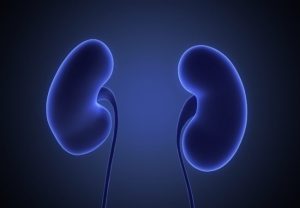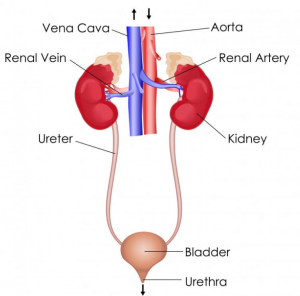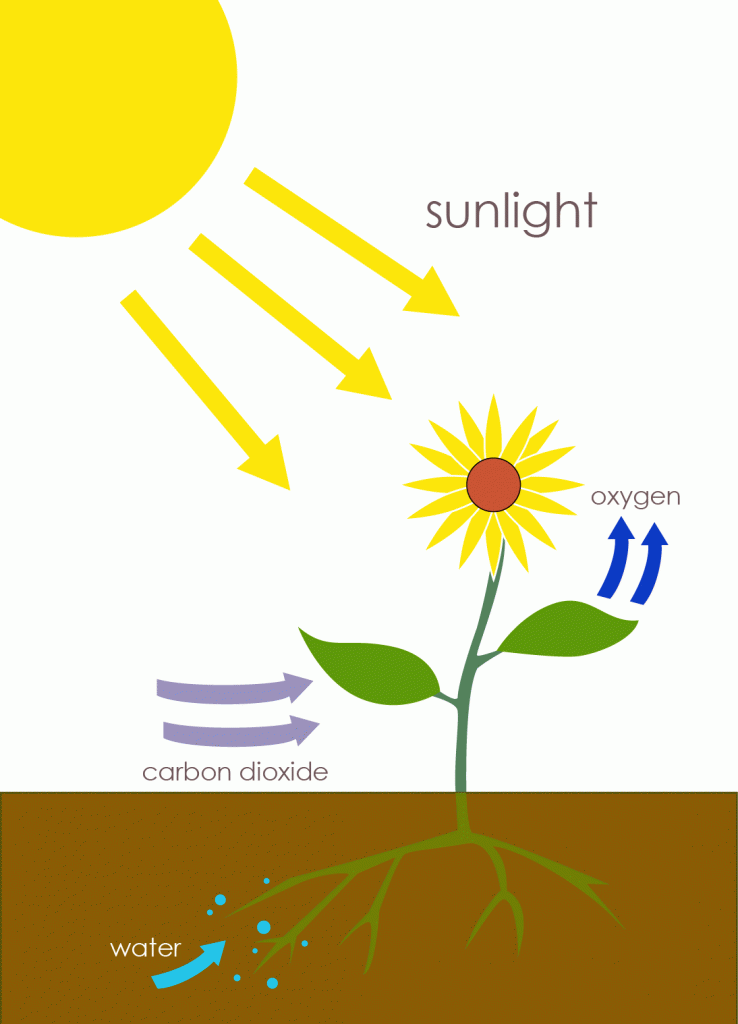Excretion
Excretion

Excretion is the process by which metabolic wastes and other non-useful materials are eliminated from an organism. In vertebrates this is primarily carried out by the lungs, kidneys and skin. This is in contrast with secretion, where the substance may have specific tasks after leaving the cell.
organism. In vertebrates this is primarily carried out by the lungs, kidneys and skin. This is in contrast with secretion, where the substance may have specific tasks after leaving the cell.
Excretion is a process of removing waste materials such as nitrogenous waste through excretory system is known as Excretion. Excretory system includes a pair of Kidneys; a pair of ureters, Urinary bladder and urethra to complete excretion process successfully.
The digestive system is responsible for taking whole foods and turning them into energy and nutrients to allow the body to function, grow, and repair itself. …Digestion of food into smaller pieces. Absorption of nutrients. Excretion of wastes.
The excretory system is the system of an organism’s body that performs the function of excretion, the bodily process of discharging wastes. The Excretory system is responsible for the elimination of wastes produced by homeostasis.
The skin contains sweat glands that excrete perspiration through skin pores. Perspiration is made up of nitrogenous wastes (urea), salts, and water. The skin is also involved in controlling body temperature.
The kidneys excrete a variety of waste products produced by metabolism into the urine. These include the nitrogenous wastes urea, from protein catabolism, and uric acid, from nucleic acid metabolism.
In mammals, excretion is the formation of urine in the kidneys, and expelling carbon dioxide from the lungs. These waste products are eliminated by urination and breathing out respectively. If excretion does not occur in an organism, waste products accumulate, which eventually kill the organism.
The digestive system is made up of the gastrointestinal tract—also called the GI tract or digestive tract—and the liver, pancreas, and gallbladder. The GI tract is a series of hollow organs joined in a long, twisting tube from the mouth to the anus.
How do plants excrete?

Plant’s excretion system is much simpler and, consequently, more inept. A plant’s molecular machines are less taxing than they are on an animal.
The numerous metabolic reactions underlying these processes produce useful products, as well as unwanted toxins. When accumulated, these toxins can be fatal. An excretory system gets rid of these toxins or metabolic waste to ensure a longer, healthier life. Plants lack complex machinery. Plants excrete through stomatal pores on their leaves. The major metabolic reactions occurring in a plant that produce this waste are cellular respiration and photosynthesis.
These processes are responsible for most of the gaseous waste produced by a plant. However, as we’ll find out, stomatal pores are not the only opening plants excrete through. This is because other than gases plants also excrete solid or gooey things.
Photosynthesis
Photosynthesis is the process by which a plant forms simple sugar in the presence of sunlight. A plant converts light energy into chemical energy, which is utilized later to fuel its metabolic reactions. A reaction between water and carbon dioxide produces sugar and oxygen molecules.
Along with melting of water, photosynthesis has to be the most consequential processes for the introduction and continuation of life forms. This is how plants provide us the air that we inhale – by breathing in the very air we exhale.
However, for them, oxygen is an undesirable toxin. The oxygen is released through pores into the surrounding air.
Respiration
Plants respire just like every organism does. Respiration is the process by which a plant converts the energy stored in the form of glucose or “food” into resourceful chemical energy. This process is essential for providing the “workers” with the energy to carry out metabolic reactions.
The gaseous waste produced when a plant cell respires is carbon dioxide. The carbon dioxide oozes through its pores and is simultaneously used as the reactant for photosynthesis. Similarly, the oxygen produced by photosynthesis is utilized for cellular respiration.
Plants obtain a voluminous quantity of carbon dioxide from animals, and in return, plants replenish us with oxygen. In this way, plants and animals share a symbiotic relationship. They live and benefit from each other. The absence of one would fatally affect the survival of the other.
Transpiration and other excreta
Plants also excrete nitrogenous compounds that are produced in protein metabolic reactions. Another method is transpiration, whereby plants excrete excess water through their leaves, which are suffused with stomatal pores, or they cause this water to profuse from fruits and stems.

Metabolic reactions also produce organic “waste”, which assumes different shapes and occupies different parts. These include gums, various oils, latex, resins and a multitude of crucial products that we borrow from plants. These substances are found on barks, succulent stems and colorful leaves.
Excretion in animals:
Many unicellular organisms like Amoeba throw out their wastes by diffusion from their body surface. Protozoan’s have no organs for excretion. As they live in an aquatic habitat, their wastes are eliminated by diffusion through the plasma membrane.
Simple multicellular organisms like Hydra throw out solid waste matter through their mouth. Higher multicellular organisms have well-defined specialized excretory organs. These organs could be simple tubular structures as in flatworms and leech.
The excretory organs of insects (e.g., grasshopper, cockroach and housefly) are also tubular. They remove nitrogenous wastes from the body fluid and help in maintaining the water balance in the body.
In vertebrates, the main organs of excretion and maintenance of water balance are the kidneys.
Excretion in Human beings

Although the kidneys are the main organs of excretion, the skin, lungs and liver also help in excretion.
Skin: Our skin has sweat glands, through which we excrete small amounts of water, urea and salts.
Liver: The liver excretes bile, which contains bile pigments. These are produced by the breakdown of old RBCs in the liver. As hemoglobin breaks down, its iron is retained, while the pigment (haem) is excreted with the bile. The liver also excretes cholesterol.
Lungs: The lungs help in getting rid of carbon dioxide, formed as a result of cellular respiration, through exhalation.
Our excretory system consists of kidneys, blood vessels that join them, ureters, urinary bladder and urethra. They help produce and excrete urine.
There are two bean-shaped kidneys that lie in the abdominal cavity, one on either side of the vertebral column. The kidneys are reddish brown. Each of them is about 10 cm long and weighs about 150 g. Although they weigh less, they receive a lot of blood for filtration.
A volume of blood nearly equivalent to that in the whole body passes through the kidneys every four or five minutes. The kidneys produce urine to filter out the waste products, like urea and uric acid, from the blood.Urine leaves each kidney through a tube called ureters. The ureters from both the kidneys are connected to the urinary bladder that collects and stores urine. Ureters carry urine from the kidneys into the urinary bladder. The urethra is a canal that carries urine from the bladder and expels it outside the body.
Internal Structure of a Kidney:
Each kidney is enclosed in a thin, fibrous covering called the capsule. A renal artery brings blood into the kidney, along with nitrogenous waste materials. After filtration in the kidney, the purified blood leaves the kidney through a renal vein.
A frontal section through the kidney reveals an outer region called the renal cortex and an inner region called the renal medulla (Figure 2). In the medulla, 5-8 renal pyramids are separated by connective tissue renal columns. Each pyramid creates urine and terminates into a renal papilla. Each renal papilla drains into a collecting pool called a minor calyx; several minor calyces connect to form a major calyx; all major calyces connect to the single renal pelvis which connects to the ureter.

Blood Supply of the Kidney & Nephrons
The kidneys are well vascularised and receive about 25 percent of the cardiac output at rest. Blood enters the kidney via the paired renal arteries that form directly from the descending aorta and each enters the kidney at the renal hila. Once in the kidney, each renal artery first divides into segmental arteries, followed by further branching to form interlobar arteries that pass through the renal columns to reach the cortex . The interlobuar arteries, in turn, branch into arcuate arteries, cortical radiate arteries, and then into afferent arterioles. The afferent arterioles deliver blood into a modified capillary bed called the glomerulus which is a component of the “functional unit” of the kidney called the nephron. There are about 1.3 million nephrons in each kidney and they function to filter the blood. Once the nephrons have filtered the blood, renal veins return blood directly to the inferior vena cava. A portal system is formed when the blood flows from the glomerulus to the efferent arteriole through a second capillary bed, the peritubular capillaries (and vasa recta), surrounding the proximal and distal convoluted tubules and the loop of Henle. Most water and solutes are recovered by this second capillary bed. This filtrate is processed and finally gathered by collecting ducts that drain into the minor calyces, which merge to form major calyces; the filtrate then proceeds to the renal pelvis and finally the ureters.
